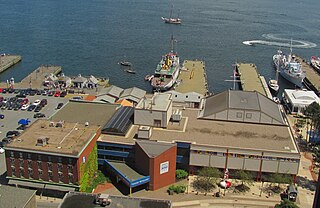
The Maritime Museum of the Atlantic is a maritime museum located in downtown Halifax, Nova Scotia, Canada.
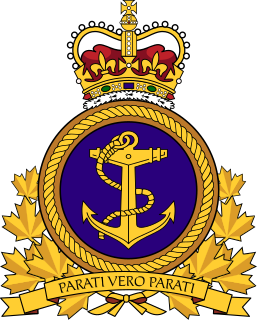
The Royal Canadian Navy is the naval force of Canada. The RCN is one of three environmental commands within the Canadian Armed Forces. As of 2021, the RCN operates 12 frigates, four attack submarines, 12 coastal defence vessels, eight patrol class training vessels, two offshore patrol vessels, and several auxiliary vessels. The RCN consists of 8,570 Regular Force and 4,111 Primary Reserve sailors, supported by 3,800 civilians. Vice-Admiral Angus Topshee is the current commander of the Royal Canadian Navy and chief of the Naval Staff.
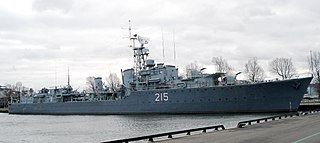
HMCS Haida is a Tribal-class destroyer that served in the Royal Canadian Navy (RCN) from 1943 to 1963, participating in World War II and the Korean War. She was named for the Haida people.

The Royal Canadian Sea Cadets is a Canadian national youth program sponsored by the Canadian Armed Forces and the civilian Navy League of Canada. Administered by the Canadian Forces, the program is funded through the Department of National Defence, with the civilian partner providing support in the local community. Cadets are not members of the Canadian Armed Forces.

HMCS Sackville is a Flower-class corvette that served in the Royal Canadian Navy and later served as a civilian research vessel. She is now a museum ship located in Halifax, Nova Scotia, and the last surviving Flower-class corvette.

USS MacKenzie (DD–175) was a Wickes-class destroyer in the United States Navy following World War I. In 1940, as part of the Destroyers for Bases Agreement she was transferred to the Royal Canadian Navy as the Town-class destroyer HMCS Annapolis.

Canadian Forces Base (CFB) Halifax is Canada's east coast naval base and home port to the Royal Canadian Navy Atlantic fleet, known as Canadian Fleet Atlantic (CANFLTLANT), that forms part of the formation Maritime Forces Atlantic (MARLANT).

HMCS Ontario was a Minotaur-class light cruiser built for the Royal Navy as HMS Minotaur (53), but transferred to the Royal Canadian Navy on completion and renamed Ontario.
Several Canadian naval units have been named HMCS Quebec.
HMCS Acadia Cadet Training Centre is a Royal Canadian Sea Cadets training centre in Cornwallis Park, Nova Scotia. The centre takes its name from the ship HMCS Acadia, a hydrographic research ship which was commissioned into the navy in both World War I and World War II and based at the end of its naval career at the Cornwallis base as a training ship. In November 1945, HMCS Acadia was decommissioned from Royal Canadian Navy service and the vessel returned to civilian operations with the Canadian Hydrographic Service as CSS Acadia. The name and unit colours of HMCS Acadia were revived in 1956 by the RCN when a new Royal Canadian Sea Cadets summer training centre was established at the naval base HMCS Protector on Cape Breton Island. It was called HMCS Acadia.

HMCS Micmac was a Tribal-class destroyer which served the Royal Canadian Navy from 1945 to 1964. Micmac was the first modern, high-performance warship built in Canada. She was the first of four Tribal destroyers built at the Halifax Shipyard and one of eight Tribal-class destroyers to serve in the Royal Canadian Navy.
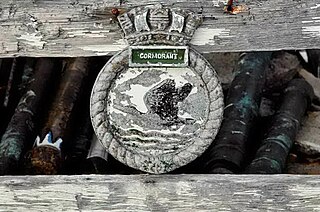
HMCS Cormorant was a diving support vessel that served in the Canadian Forces. She was equipped with two SDL-1 submersibles. The ship was the first in the Canadian Forces to have women assigned to their crew. Initially constructed as the trawler Aspa Quarto in 1965, the ship was acquired by the Canadian Forces in 1975 and renamed Cormorant. The vessel remained in service until 1997 when Cormorant was sold to a US buyer. The ship was laid up at Bridgewater, Nova Scotia in 2000 and was removed on 18 November 2020 to be scrapped in Sheet Harbour.

Canadian Forces Base Cornwallis is a former Canadian Forces Base located in Deep Brook, Nova Scotia.

CSS Acadia is a former hydrographic surveying and oceanographic research ship of the Hydrographic Survey of Canada and its successor the Canadian Hydrographic Service.

HMCS Antigonish was a River-class frigate that served in the Royal Canadian Navy from 1944–1946 and as a Prestonian-class frigate from 1957–1966. She is named for Antigonish, Nova Scotia. Her photo is featured on the cover of the 1994 album Frigate by the band April Wine.

HMCS Chaudière was a Restigouche-class destroyer and the second vessel of her class that served in the Royal Canadian Navy and later the Canadian Forces from 1959 to 1974. She was the second Canadian naval unit to bear this name. During the summer of 1974 she along with her sister ship HMCS Columbia served as the base of operations for the Esquimalt Sea Cadet Camp while being docked at the DND jetty in Colwood. This location was across the harbour from the main site of CFB Esquimalt. Following the vessel's decommissioning, the ship was used as a source for spare parts for the other surviving members of her class. In 1991, Chaudière was sold for use as an artificial reef and sunk off the coast of British Columbia.

HMCS Oriole is the sail training vessel of the Royal Canadian Navy based at CFB Halifax in Halifax, Nova Scotia. She is a sailing ketch, currently the oldest commissioned vessel in the Royal Canadian Navy, and also the longest serving commissioned ship. Originally the yacht Oriole IV, the vessel was acquired by the Royal Canadian Navy during the Second World War, then returned to private ownership at the end. Oriole IV was reacquired during the Cold War for use on the East Coast of Canada before switching to the West Coast of Canada in 1956. In 2018, the training vessel returned to the East Coast.
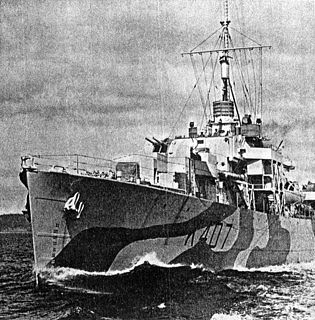
HMCS Beacon Hill was a River-class frigate that served in the Royal Canadian Navy (RCN) as an ocean convoy escort during the Second World War. She fought primarily in the Battle of the Atlantic. In 1954 she was converted to a Prestonian-class frigate and served until 1957. She was named for Victoria, British Columbia, but because HMS Victorious was in service with the Royal Navy, the RCN, in an effort to avoid confusion, chose to honour the city by choosing another name associated with it.

Nova Scotia is a Canadian province located in Canada's Maritimes. The region was initially occupied by Mi'kmaq. The colonial history of Nova Scotia includes the present-day Canadian Maritime provinces and the northern part of Maine, all of which were at one time part of Nova Scotia. In 1763 Cape Breton Island and St. John's Island became part of Nova Scotia. In 1769, St. John's Island became a separate colony. Nova Scotia included present-day New Brunswick until that province was established in 1784. During the first 150 years of European settlement, the colony was primarily made up of Catholic Acadians, Maliseet and Mi'kmaq. During the latter seventy-five years of this time period, there were six colonial wars that took place in Nova Scotia. After agreeing to several peace treaties, this long period of warfare ended with the Halifax Treaties (1761) and two years later when the British defeated the French in North America (1763). During these wars, Acadians, Mi'kmaq and Maliseet from the region fought to protect the border of Acadia from New England. They fought the war on two fronts: the southern border of Acadia, which New France defined as the Kennebec River in southern Maine. The other front was in Nova Scotia and involved preventing New Englanders from taking the capital of Acadia, Port Royal, establishing themselves at Canso.

HMCS Baddeck was a Flower-class corvette that served with the Royal Canadian Navy during the Second World War. She served in several theatres of operations during the war. After the war the ship was retired but the ship's name, pennant number and badge continue to be used by the K147 Baddeck Royal Canadian Sea Cadets Corps.

















